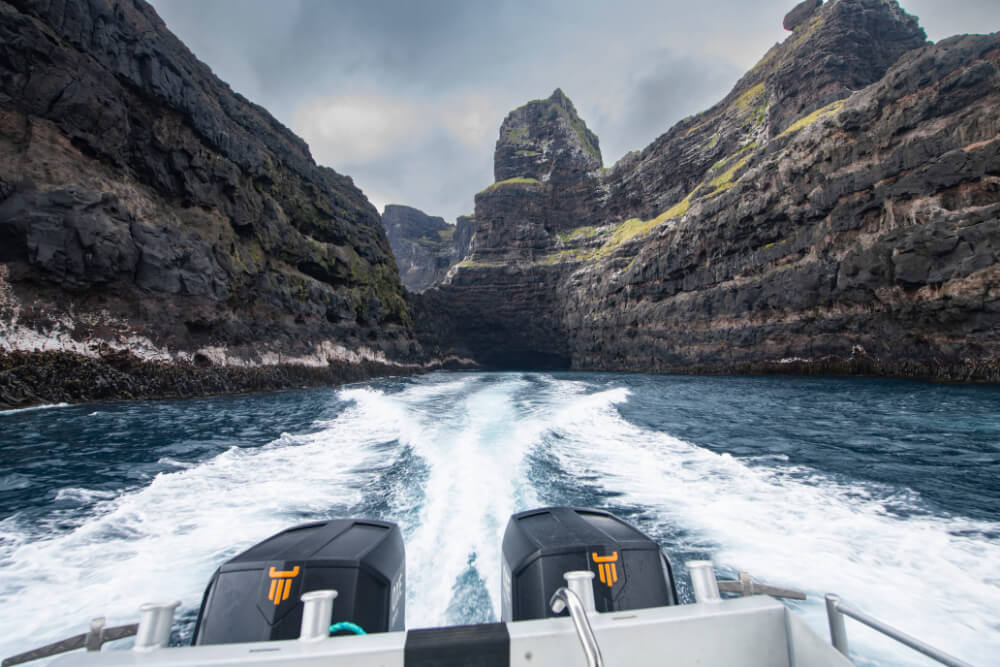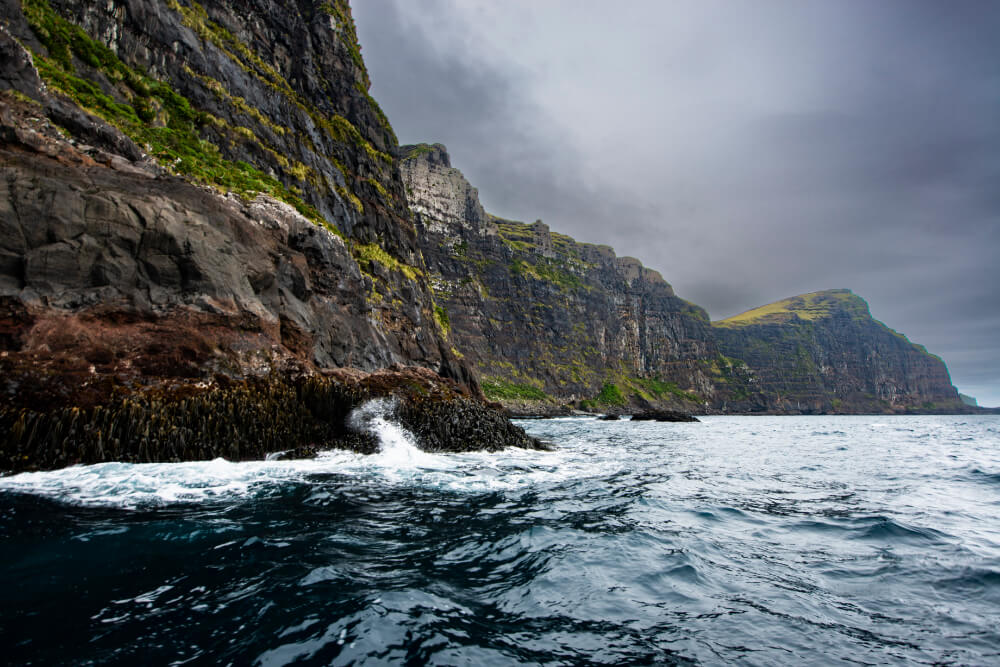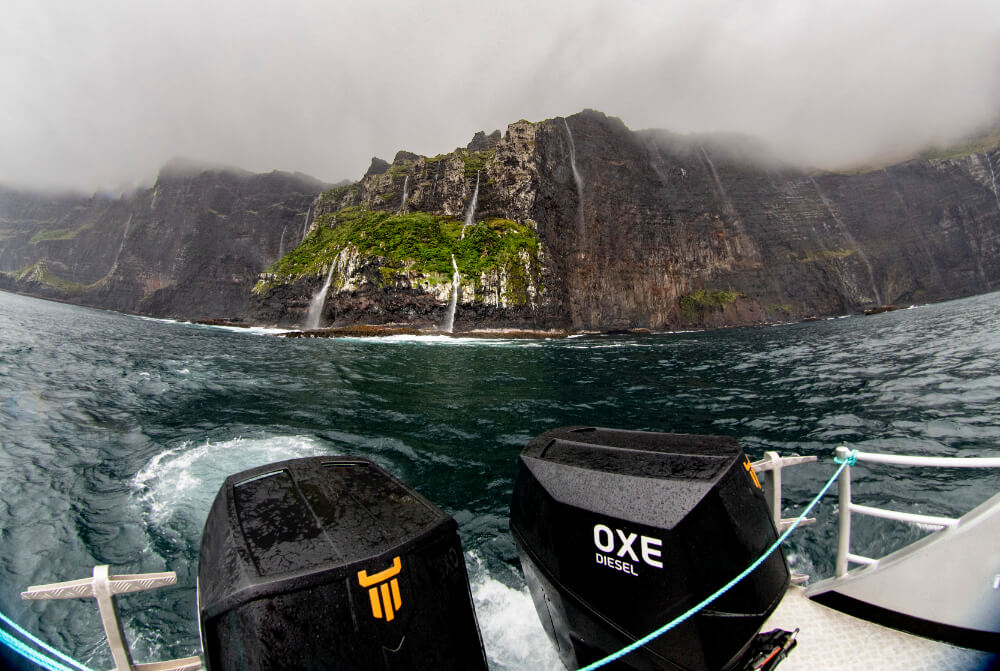Cruising of the Adams Cliffs, Auckland Islands.
search for the General Grant
Story by Mark Timmerman.
When the Image Boats built Seastar isn’t deployed on commercial workboat duties or tourism charters in the spectacular waters of Fjordland on the west coast of New Zealand’s South Island, she is hunting for one of the world’s most famous and sought-after shipwrecks, the General Grant. Owner Bill Day wanted Oxe Diesel Outboards on the back of this multi-purpose vessel – and he is certainly very happy with his choice!
With the first set of Oxe diesel outboards installed on a vessel in New Zealand, Bill Day’s multi-purpose monohull vessel Seastar may very well achieve another “first” if its hunt for the famous General Grant shipwreck is successful.
Chairman of the Seaworks group of companies, Bill is well versed in the job of providing services to offshore, subsea, aquaculture and hydrographic industries with a fleet of specialised vessels and equipment. But when possible, Bill’s other passion is finding shipwrecks.
“To be honest, I probably didn’t want to be the first to be trying out the Oxe Diesel’s, but I couldn’t be happier with their performance,” Bill says.
After returning from a six-week expedition searching for the General Grant around the Auckland Islands, the twin 200hp Oxe Diesel outboards on Seastar proved just how well these relatively new players in the outboard market perform.
“We’re towing a magnetometer behind Seastar close to the cliffs around the islands there,” explained Bill of the General Grant search, “so the engines are running at lower speed towing that equipment behind at around 3knots for long periods.”
Working in close to the rock cliffs of the Auckland Islands requires vigilant skippering, (a calm day in this area of the sub-Antarctic still delivers a 1.6 to 1.8 m swell), and Bill says the vessel operates in those tows with one engine doing the work “and the other engine just running at idle – they’ll happily run like all day that if you need to and we keep the other engine running in case we need to move out of danger quickly.”
GOOD PERFORMER
Seastar is not exclusively a “go-slow” vessel. Built by Invercargill based Image Boats, her top speed is a respectable 27 knots, but she will happily hold 20 knots with the Oxe Diesels running at 3,800rpm. That kind of performance is a marvellous showcase of just how strong the twin 200hp Oxe diesels are – delivering real horsepower right through their rev range.
“She is comfortable at those revs and fuel consumption is very impressive. We’re only using 30 lph per engine at 20 knots,” Bill said.
Bill says the Oxe diesel’s are “quiet” at cruising speeds, and describes their low-speed trolling abilities as “very good”.
“The engines were set up to get speed out of them, but if the vessel’s work tasks changed and we needed more torque than speed, the Oxe’s are easy to reconfigure for those tasks”.
Bill is referring to the unique belt-drive system on the Oxe diesel outboard that runs a drive belt from the engine down the leg of the outboard to the propeller shaft. This system allows not only interchangeable gear ratios catering for workhorse duties or high-speed operation, but also counter-rotation configuration and crash-stop robustness.
The already impressive diesel torque of the proven 2.0 litre European engine (415Nm @ 2,500rpm) is doubled at the propeller shaft (around 900Nm). Try getting those torque numbers out of a petrol outboard!

At 10.75 m and hosting live-aboard facility for short periods along with 200 litres of water carrying and 1,000 litres of fuel, Seastar is a serious piece of aluminium work or tour boat.
“We had her built in 2021 with plenty of under-canopy area because it’s pretty much always raining down this end of New Zealand,” Bill said.
Nothing beats local knowledge of course and among other custom additions is a unique water collection “funnel” system on the vessel that allows the skipper to position the boat’s bow under one of the many waterfalls that empty off cliffs into the fjords around this part of New Zealand and fill her onboard water tank.
“We’ve also set up the canopy system to be a rainwater collection system too, so we can replenish the fresh water easily which saves on weight and improves performance,” Bill said.
Sea-going and commercial experience has given Bill a keen eye for good design in maritime equipment and he loves many features of the Oxe diesel outboards on Seastar.
“I’ve always known that every boat is a compromise of some kind, but we really tried to avoid too much compromise with Seastar. There were some teething issues with the engines, but Oxe made sure they were solved,” Bill says.
“You have to give them full marks for how they stand behind their product.

“The longer service intervals are handy for us too. We’re in a remote area and bringing in mechanics is another logistical exercise down here in Fjordland so we need to attend to less often,” Bill said.
The biggest advantage with the Oxe diesels for Bill and his operations is the fuel of course – both for the safety and ease of storage and transport of the much less volatile diesel and its ability to be compatible with larger mothership operations as a single fuel source.
“There’s no doubt the diesel advantage is a big factor for us, (petrol can be a problem to transport into these areas), but they are an incredibly well-designed engine too, with the pumps and service points all at the top and front of outboard,” Bill says.
“They are also quick to react in gear changes, but I have to say I haven’t dared try to test their limits even though Oxe say the electronically-controlled gearbox protects itself against a mistake by the skipper.”
Bill is referring to Oxe diesel outboard’s Quick-Shift-Capability (QSC) and Low-Speed-Control (LSC) features. As a result, the user has a refined and smooth control over the vessel with full maneuverability, even below four knots. The gearbox is not only above the waterline, (as opposed to the traditional submerged and vulnerable position of a traditional outboard gearbox), but its QSC and LSC electronic control provide protection against damage in the case of an inadvertent or panic gear shift at high revs.
“With a 10m vessel you lose a lot of boat when you put inboards in, especially twin engines. I would recommend the Oxe diesels for all smaller work vessels for sure,” Bill says.
THE SEARCH CONTINUES
The waters of the sub-Antarctic at around the 50 deg latitude south could as aptly be labelled the “roaring 50’s” as the more commonly-known “roaring 40’s”.
These are cold and very unforgiving waters – as the 83 souls aboard the sailing ship General Grant were to tragically find out first-hand in 1866 as their ship went down, (with a reported 2,576 ounces of gold amongst her cargo), against the cliffs of the Auckland Islands.
The 1,005 tonne, 180-foot General Grant is one of the most sought-after wrecks in the world and perhaps none are keener to find it than Bill Day.
“On our last six-week expedition, we probably only had around seven days where the seas were calm enough to search – keeping in mind that a “calm” day is still around a 1.6 to 1.8 metre sea,” Bill explains.


A keen wreck hunter for many years, Bill has discovered two other historic wrecks from the 1830’s and 1860’s over the five expeditions he has undertaken so far to locate the General Grant.
Bill doesn’t just lead these searches – he is very hands on, including donning specialist dry-suit diving gear to investigate the bottom when Seastar’s magnetometer indicates a possible wreck site. Five expeditions without success in finding the General Grant have not broken Bill’s spirit in the search for this elusive wreck.
“If anything, it has probably just made me more curious about what strategy we use next,” Bill says.
“Has she disappeared under a landslide perhaps? Or is the information about where she went down accurate?”
For sure, Bill’s Kiwi spirit will prevail; “Us New Zealanders have a saying about achieving such goals which is ‘knock the bastard off’, (originally quipped by Edmund Hilarly”.
“It’s the wreck to find in the South Pacific,” Bill says.




